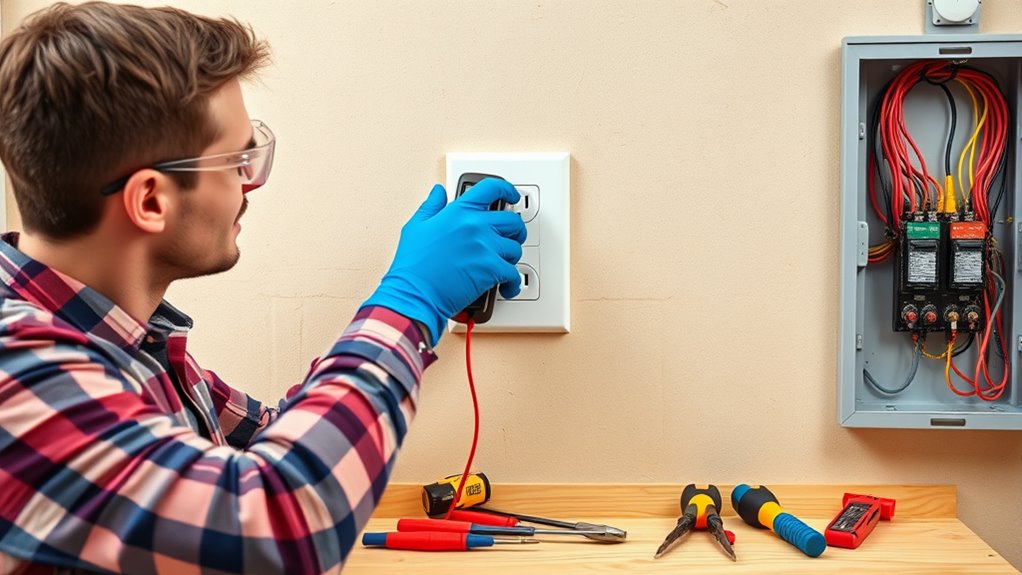To start basic home electrical repairs, you need to understand your system’s grounding and how to safely turn off power at the main panel. Always wear insulated gloves and use proper tools like a voltage tester. Confirm circuits are dead before working and follow wiring color codes. If you’re unsure about connections or encounter issues, it’s safer to call a professional. Keep safety first—if you want to learn more, there’s plenty to discover to help you work confidently.
Key Takeaways
- Always turn off the main power and verify with a voltage tester before starting any electrical repair.
- Understand wiring color codes (hot, neutral, ground) to ensure correct connections.
- Use insulated tools and wear protective gear like gloves and goggles for safety.
- Follow electrical codes and proper grounding techniques to prevent shocks and hazards.
- Seek professional help for complex repairs, persistent issues, or if uncertain about procedures.
Understanding Your Home’s Electrical System
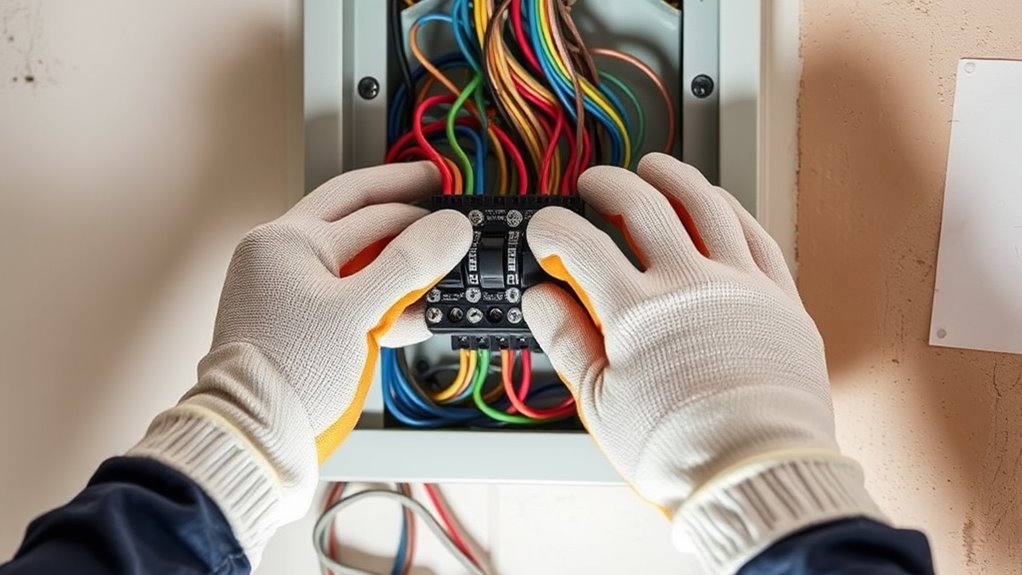
Understanding your home’s electrical system is essential before attempting any repairs. You should know that grounding systems are critical for safety, providing a safe path for electricity to travel in case of a fault. Proper grounding helps prevent shocks and protects your appliances. Additionally, your home’s wiring must comply with electrical codes, which set the standards for safe installations. Familiarize yourself with the main electrical panel, circuits, and how power flows through your home. Recognizing the components and their functions allows you to troubleshoot issues effectively. Always remember that following electrical codes isn’t just about legality; it’s about ensuring safety for everyone in your household. Understanding grounding systems is fundamental for safety and proper electrical system function. Before working on your system, understand these basics to minimize risks and make informed decisions. Being aware of circuit breakers and fuses can also help prevent electrical hazards and protect your wiring from overloads.
Essential Tools and Safety Equipment
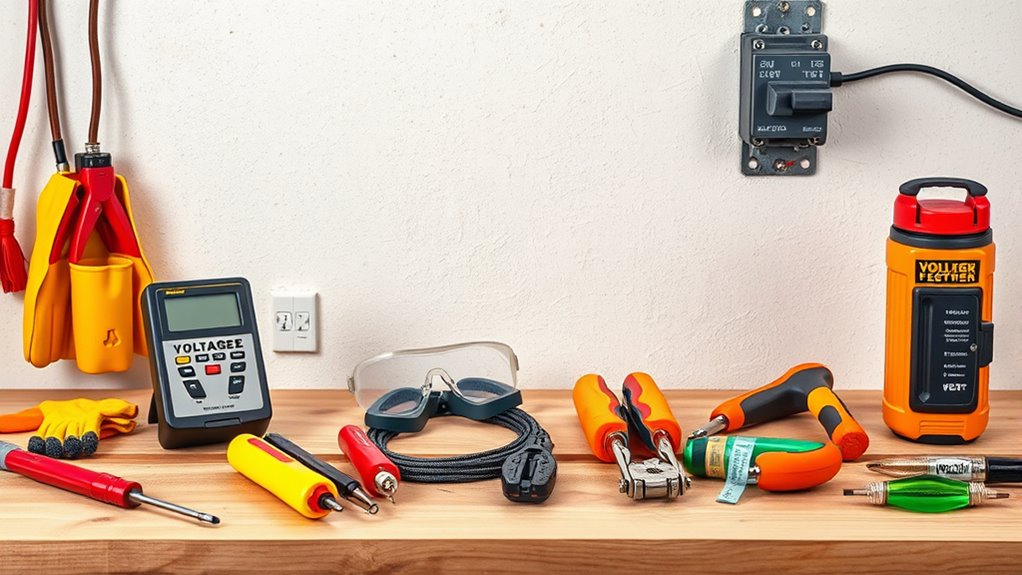
Before starting any electrical repair, make sure you have the right protective gear, like insulated gloves and safety glasses, to keep yourself safe. You’ll also need basic hand tools such as screwdrivers, pliers, and a voltage tester to do the job properly. Always follow safety protocols, including turning off the power and working in a dry environment, to prevent accidents.
Protective Gear Necessities
Protective gear is vital to keep you safe when working on electrical repairs around your home. Your personal safety depends on proper equipment to prevent injuries. Make sure you have the right protective gear before starting any project. Key items include:
- Insulated gloves to protect against electrical shocks
- Safety goggles to shield your eyes from sparks or debris
- Rubber-soled shoes to insulate you from the ground
- Long-sleeved, non-conductive clothing to minimize skin exposure
Wearing this gear reduces risks and guarantees you stay safe during repairs. Always double-check that your protective equipment is in good condition before beginning work. Remember, prioritizing personal safety with the right gear is essential for successful and safe electrical repairs. Additionally, using proper protective equipment is crucial to minimize hazards associated with electrical work, especially considering the importance of electrical safety standards that guide proper protective measures. Proper training and adherence to safety protocols help ensure you follow best practices for a safe working environment. Incorporating personal protective equipment such as face shields and ear protection can further enhance safety during complex repairs, and understanding the types of protective gear available can help you select the most appropriate items for each task.
Basic Hand Tools
To safely and effectively perform home electrical repairs, you need a set of essential hand tools and safety equipment. Start with a multimeter to check voltage and continuity, and a wire stripper for cleanly removing insulation. Pliers, especially needle-nose, help grasp wires and tighten connections. A voltage tester ensures circuits are de-energized before working. Familiarize yourself with wire color codes—black or red for hot, white for neutral, and green or bare for ground—to avoid errors. A circuit breaker finder can identify circuits quickly, preventing overloads. Always consider the circuit capacity—knowing the amperage limits prevents tripping breakers or hazards. Keep your tools insulated and in good condition to work safely and efficiently during repairs.
Safety Protocols
Having the right tools is just the first step; using proper safety equipment guarantees you stay safe throughout the repair process. Always wear insulated gloves and safety goggles to protect against shocks and debris. Keep a voltage tester nearby to confirm circuits are dead before working. Use grounding techniques, like properly grounding yourself and tools, to prevent static buildup or accidental shocks. Keep a fire extinguisher accessible in case of electrical sparks. Prepare for emergencies with a first aid kit and know emergency procedures. Remember, safety comes first—never bypass safety equipment or grounding protocols. Staying alert and prepared ensures your electrical repairs are safe and effective, minimizing risks and protecting you throughout the process.
Recognizing and Turning Off Power Safely
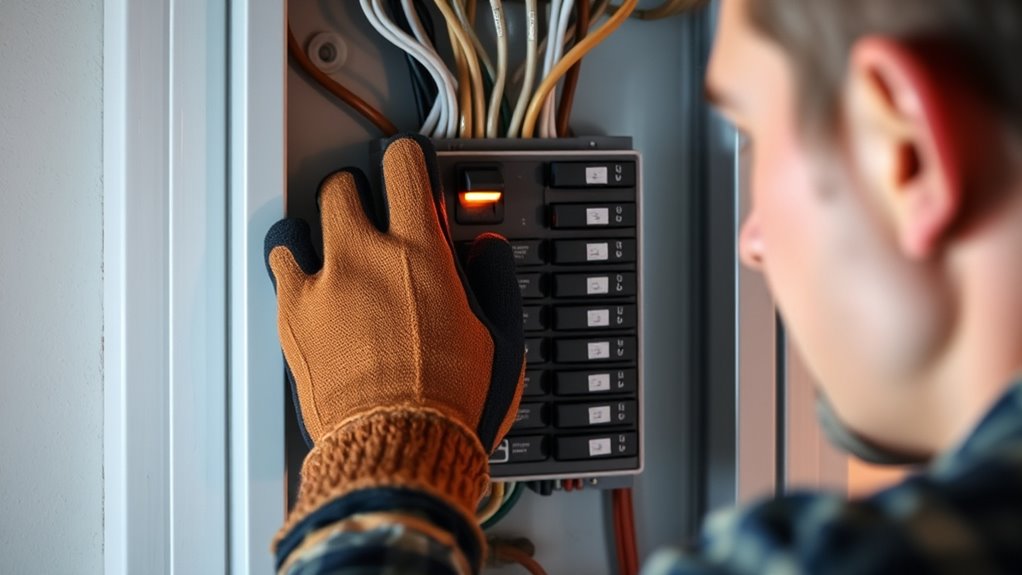
Before starting any repair, locate your main power switch and turn it off to cut the electrical supply. Confirm that the circuit breaker controlling the area is properly switched to the off position. This guarantees your safety and prevents accidental shocks while working. Additionally, understanding home security systems can help you recognize potential safety features or alerts that may be present in your electrical setup. Being aware of electrical safety guidelines can further help you prevent hazards and ensure proper handling during repairs. Remember that identifying bad lemon juice signs can be analogous to recognizing faulty wiring or components that may indicate a problem in your electrical system. Familiarizing yourself with security features can also provide additional safety measures during electrical work.
Identifying Main Power Switch
Locating the main power switch is a crucial first step before beginning any electrical repair. You need to verify the entire system is safely shut off. Typically, you’ll find the main switch near the electrical panel or fuse box. Look for a large, clearly labeled switch or breaker. Check for signs of a ground fault or devices like surge protectors connected to the main line, which can help identify the primary switch. Remember, turning off the main switch cuts power to all circuits, reducing shock risks. Be cautious if the switch is hidden behind panels or in less obvious locations. If unsure, consult your home’s wiring diagram or contact a professional. Always double-check that power is off before proceeding to avoid accidents.
Ensuring Circuit Breaker Off
To guarantee safety, always recognize and turn off the circuit breaker before working on any electrical components. Start by locating the circuit breaker panel and reading the circuit breaker labels, which identify the specific areas or appliances they control. Confirm the correct breaker by following the power outage procedures, such as testing the circuit with a voltage tester or turning off the main switch if needed. Never guess or rely solely on visual cues—properly shutting off the breaker ensures no current flows to the circuit. Remember, turning off the circuit breaker is essential to prevent electrical shocks or short circuits. Once the breaker is off, double-check by testing the outlet or fixture before beginning any repairs, confirming the power is completely shut off. Additionally, understanding the importance of circuit breaker labels and user privacy can help you stay informed about safety and security practices when working with electrical systems. Familiarizing yourself with home electrical codes can further enhance your safety and compliance during repairs. Recognizing the significance of power shut-off procedures can also prevent potential hazards and ensure a safer working environment. Being aware of the noise levels of modern heat pumps can also help you plan repairs or upgrades with minimal disturbance to your household.
Replacing or Repairing Outlets and Switches
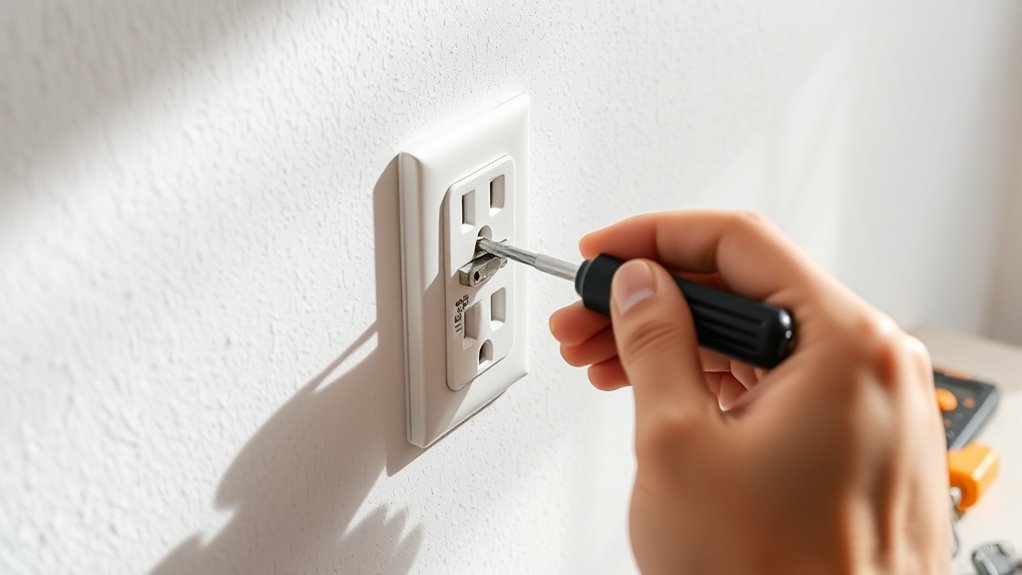
Replacing or repairing outlets and switches is a straightforward task that can improve your home’s safety and functionality. First, turn off the power at the circuit breaker. When working with outlets and switches, consider grounding methods to guarantee safety. Understanding switch types helps you choose the right replacement, whether single-pole, three-way, or dimmer switches. To get started:
- Turn off the power and verify with a tester
- Remove the faceplate and unscrew the device
- Note or photograph wire connections before disconnecting
- Connect new outlets or switches following the original wiring, paying attention to grounding and switch types
Proper grounding methods are vital to prevent shocks. Always double-check connections and test before restoring power, ensuring a safe and successful repair. Incorporating the correct grounding techniques can significantly enhance safety during electrical repairs. Additionally, researching Gold IRA Rollovers can help diversify your retirement savings for long-term security. Remember, understanding electrical safety procedures is essential for preventing accidents and ensuring a successful repair process. For added safety, consider using a circuit tester to confirm that power is fully off before beginning work.
Troubleshooting Common Electrical Problems
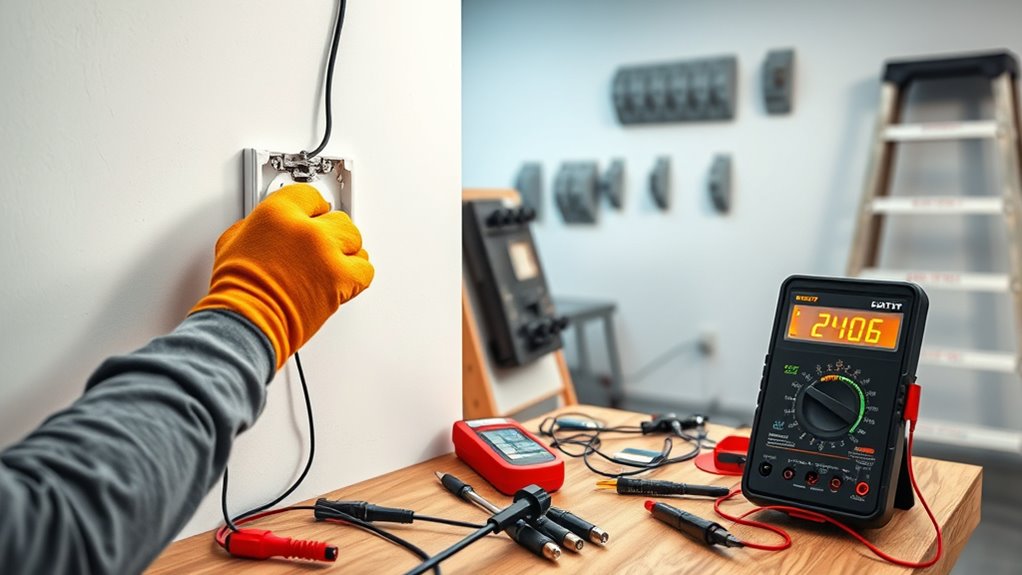
After successfully replacing or repairing outlets and switches, you might encounter new issues that disrupt your home’s electrical flow. Troubleshooting common electrical problems begins with evaluating the circuit. Use wiring diagrams to identify the correct wiring paths and connections. If a circuit isn’t working, check the circuit breaker or fuse first—sometimes a simple reset or replacement solves the problem. For outlets or switches that don’t function properly, verify wiring connections, ensuring they match the diagram. Look for loose or damaged wires, and tighten or replace as needed. If outlets still malfunction, test for power with a voltage tester. Remember, always turn off power before inspecting wiring, and consult wiring diagrams to avoid errors. This approach helps isolate issues quickly and safely. Additionally, understanding home electrical safety is essential to prevent accidents during troubleshooting.
Wiring Basics and Connections
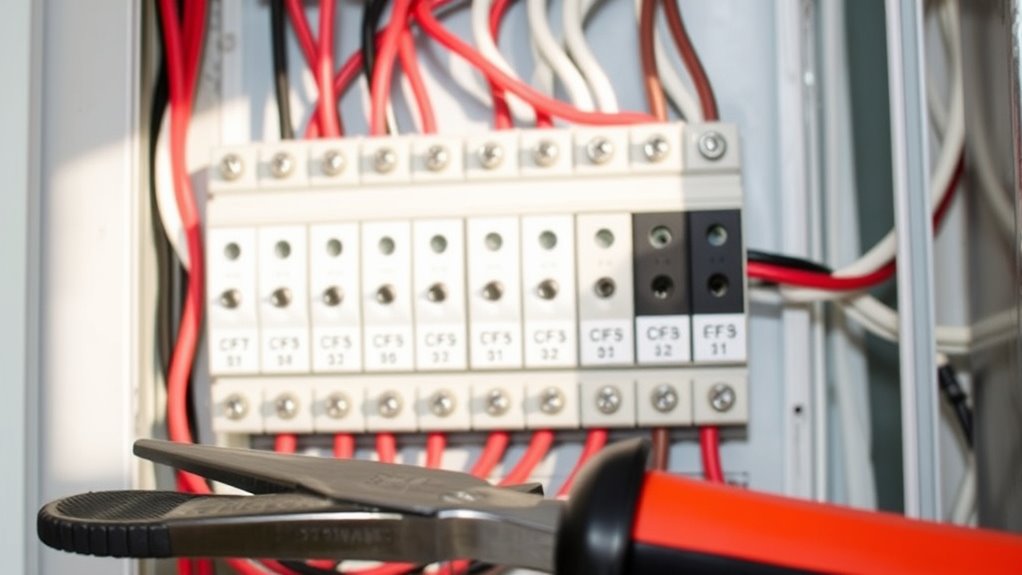
Understanding wiring basics is essential for safe and effective electrical repairs around your home. Proper connections ensure safety and functionality. Start by familiarizing yourself with wire color codes: black or red for hot wires, white for neutrals, and green or bare copper for grounding. When making connections:
- Always turn off power at the breaker before working.
- Use grounding techniques to prevent shocks and ensure safety.
- Secure wires tightly to terminals, avoiding loose connections.
- Follow standard wire color codes for consistency and safety.
Knowing how to identify and connect wires correctly reduces risks and improves your repair skills. Proper grounding techniques protect you from electrical faults, while understanding wire color codes helps you work confidently. Keep these basics in mind, and always prioritize safety when handling electrical wiring.
When to Call a Professional Electrician
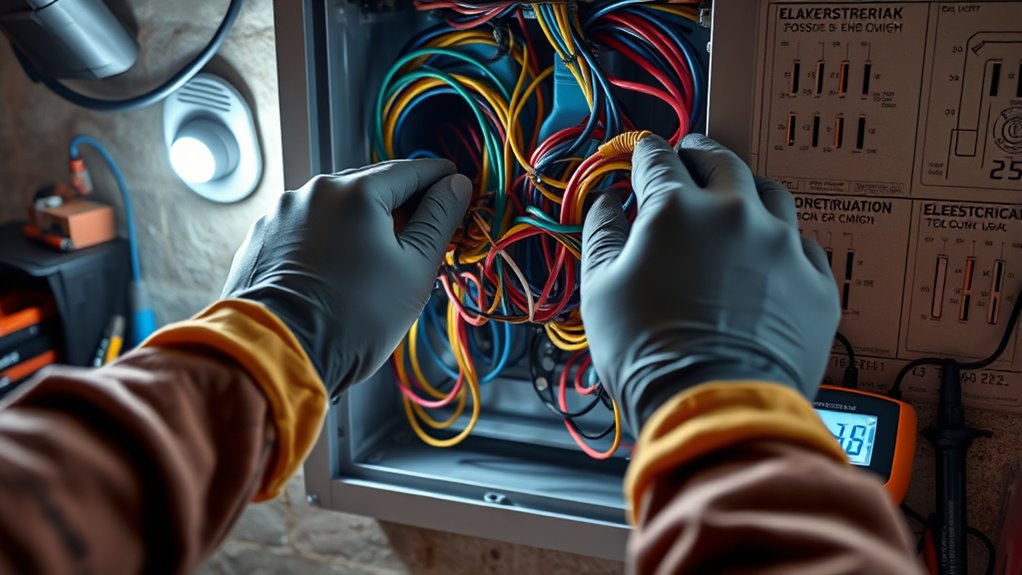
Knowing when to call a professional electrician is crucial for your safety and the integrity of your home’s electrical system. If you encounter issues like persistent tripping breakers, sparks, or circuit overloads, it’s a clear sign you need expert help. Attempting complex repairs without proper knowledge increases DIY risks and may violate local code safety standards. Don’t ignore problems that involve wiring behind walls, unfamiliar electrical components, or signs of damage like burning smells or discolored outlets. Trying to fix these on your own can lead to electrical fires or shocks. When in doubt, it’s best to hire a licensed electrician. They have the experience, tools, and knowledge to ensure repairs are safe, compliant, and durable, protecting your home and loved ones.
Frequently Asked Questions
How Do I Identify the Main Electrical Panel in My Home?
To identify your main electrical panel, look for a large metal box usually located in the basement, garage, or utility area. It contains the circuit breaker, which controls power to your home. Open the panel door carefully; the main breaker is typically a large switch at the top or side. Once found, this electrical panel is your central hub for managing and troubleshooting your home’s electrical system.
What Are the Signs of Outdated or Faulty Wiring?
When it comes to outdated or faulty wiring, it’s better to be safe than sorry. During a wiring inspection, look for signs like flickering lights, frequent circuit overloads, or warm outlets. Frayed or discolored wiring also indicates trouble. If you notice any of these issues, don’t brush them off — they’re warning signs that your wiring might need an upgrade to prevent potential hazards. Stay vigilant to keep your home safe.
Can I Install New Outlets or Switches Myself?
You can install new outlets or switches yourself, but prioritize DIY safety. Always turn off the power at the breaker before starting. Familiarize yourself with outlet types and wiring diagrams. Use proper tools and guarantee secure connections. If you’re unsure or uncomfortable, it’s better to consult a professional. Proper installation not only keeps you safe but also guarantees your outlets and switches function correctly, avoiding potential electrical hazards.
How Often Should I Inspect My Home’s Electrical System?
Imagine discovering a flickering light that hints at an underlying problem. You should inspect your home’s electrical system at least once every year to guarantee electric safety. Regular inspections help catch issues early, preventing potential hazards like shorts or fires. By maintaining a consistent inspection frequency, you protect your family and property, giving you peace of mind. Don’t wait for warning signs—be proactive with your electrical safety.
What Are the Common Causes of Electrical Fires in Homes?
Electrical fires often start from circuit overloads and electrical surges. You might cause overloads if you plug in too many devices into one outlet or extension cord. Surges, often from lightning or faulty wiring, can damage your system and spark fires. To prevent this, avoid overloading circuits, use surge protectors, and schedule regular inspections. Staying aware of these risks helps keep your home safe from electrical fires.
Conclusion
By understanding your home’s electrical system, you might find yourself confidently fixing a flickering light or replacing a faulty outlet, just as a sudden storm clears to reveal a calm, starry night. With the right tools and safety precautions, you’ll be prepared to handle common issues, turning what once seemed intimidating into a manageable task. Remember, sometimes the most surprising solutions come when you least expect them, illuminating your path to safer, smarter home repairs.

